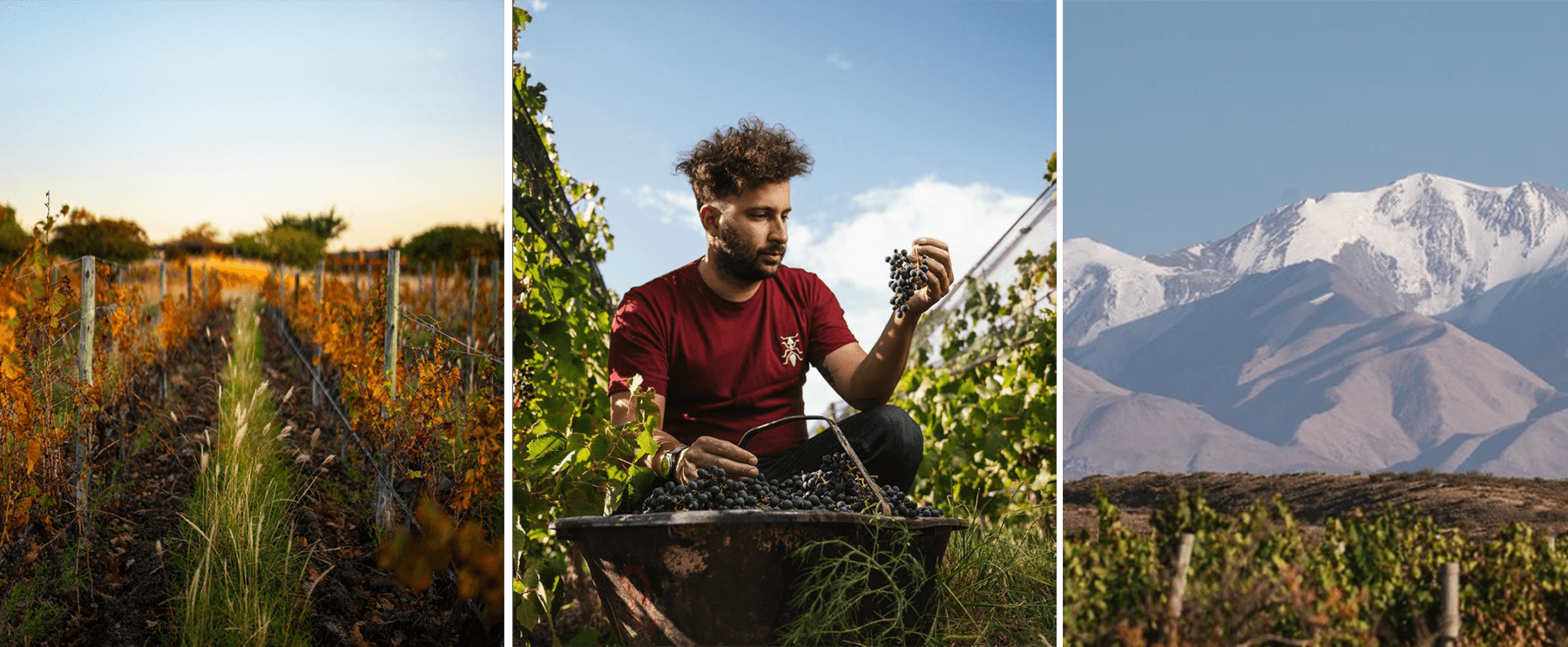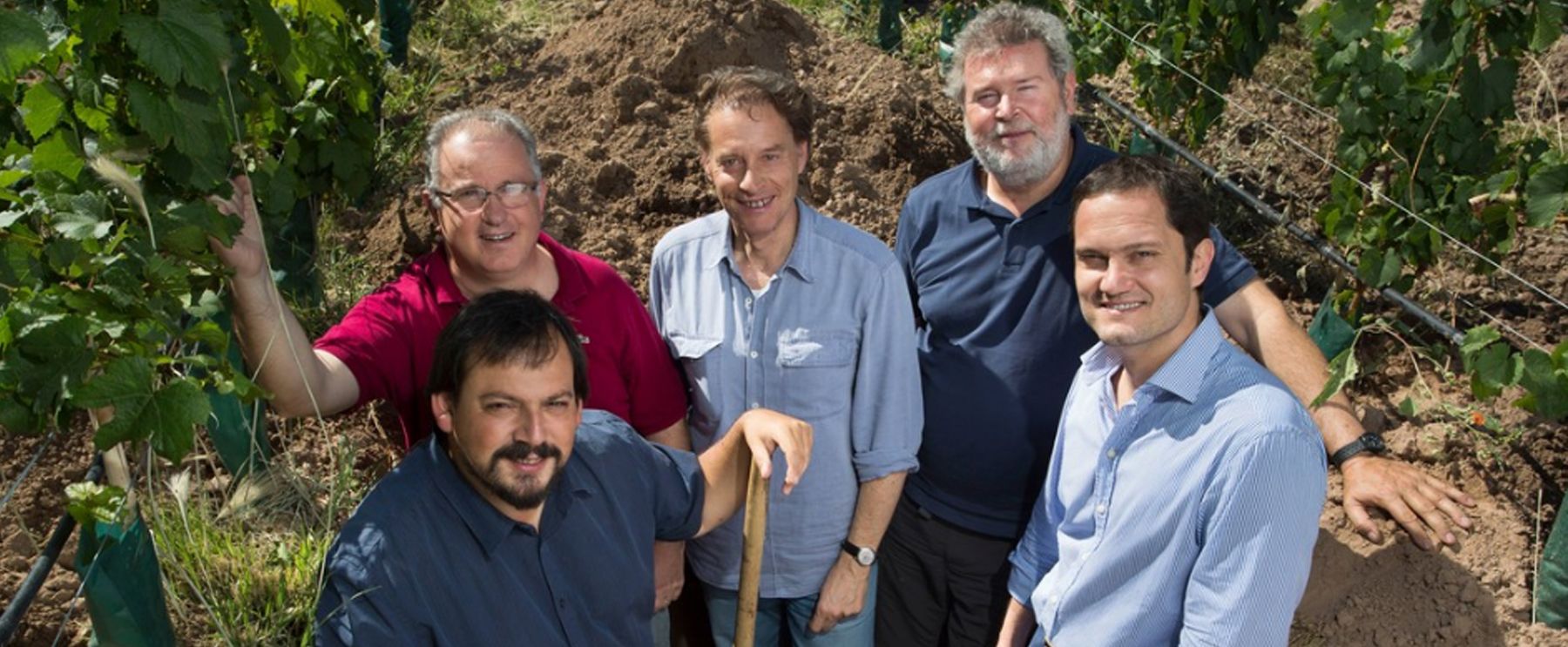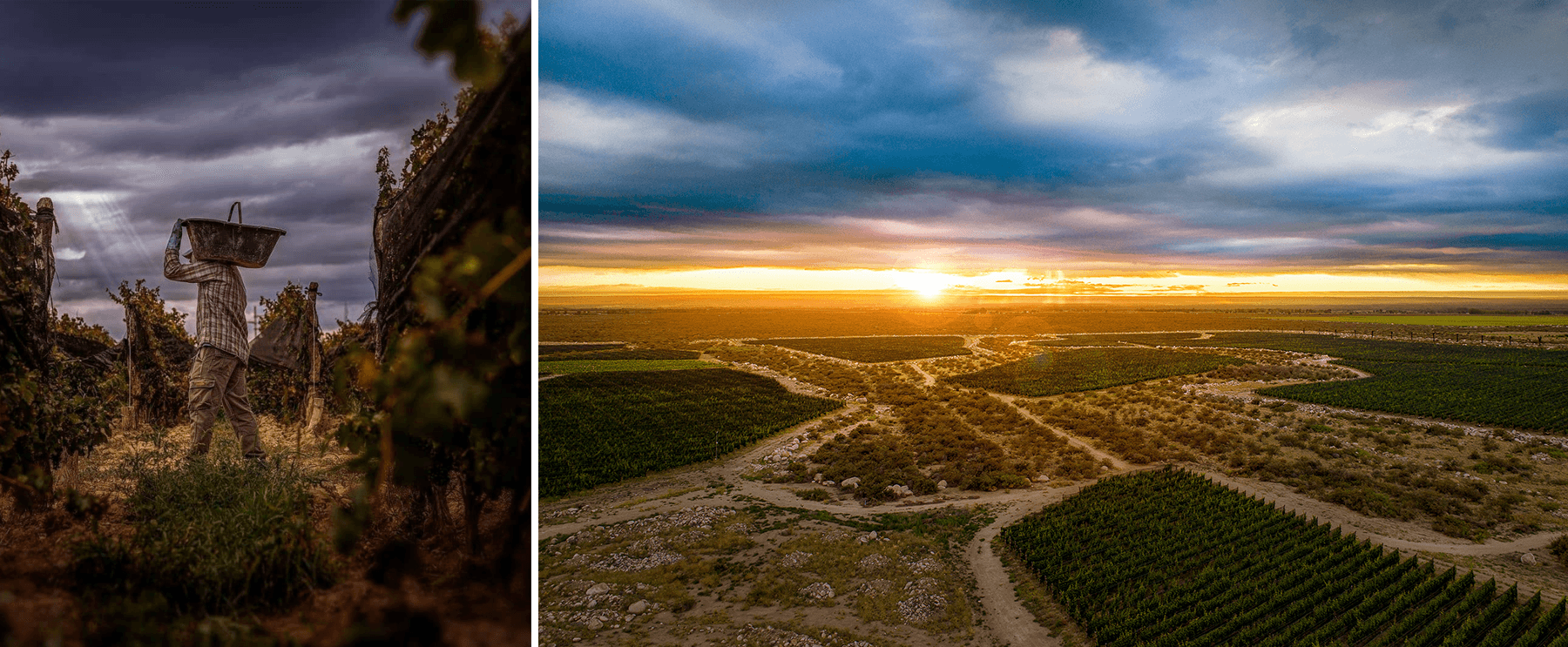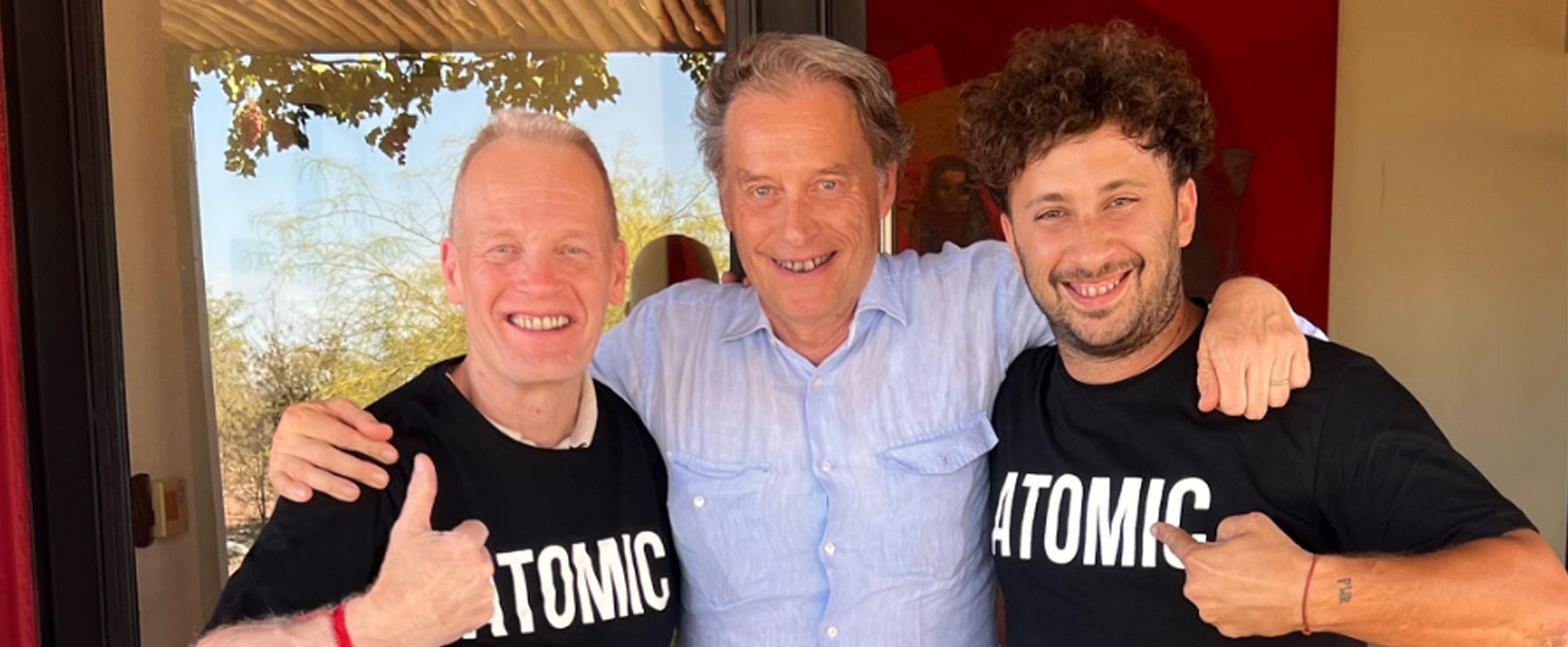In 2020, Federico Gambetta was appointed winemaker at Altos Las Hormigas. By 2021, he was making 100-point wines and propelling this highly respected Argentinian winery into a new era. 2024 marks Federico’s first visit to the UK with Altos Las Hormigas and we jumped at the opportunity to get to know the man behind the wines.
For more information about purchasing the wines of Altos Las Hormigas, please contact your Account Manager. Not yet a customer? Contact Us to discuss opening an account.
You are relatively new to Altos Las Hormigas, having joined in 2020. What was your background before?
I joined Altos when I was 31, but I started my career in the wine industry when I was 18. Both of my grandparents had wineries, so I’ve been around wine ever since I was a child. When I started my degree in Agricultural Engineering, I spent time in research facilities in Mendoza, studying the effects of climate change on Malbec. After my degree, I went to Montpellier in France to work a vintage before winning a scholarship to continue my research on Malbec and climate change, but this time with a focus on Australia - though I was still based in Mendoza.
I started working with Catena Zapata then, as well as doing a vintage at Cardinale in Napa. It was there that the Rothschild family, of Chateau Lafite, offered me the winemaker role at Bodegas CARO, their joint venture with Cantena Zapata. I was with them for seven years.
What made you decide to focus your studies on Malbec and climate change?
All over the world, the climate is definitely changing, and it’s important to understand how to manage this going forward. In Argentina, we needed to think about what tools could help maintain the quality of Malbec. What can we do to preserve the environment? Malbec is really, really important in Argentinian winemaking. It’s a key factor for us. My purpose is to care for 100-year-old vines, to manage their viticulture, to prune and care for them, and to make sure they last another 100 years.

You have spent a lot of time focused on viticulture. What made you decide to become a winemaker?
My grandparents had a role in the decision, but I think, in a way, it was something that I didn’t choose. It’s something that chose me. I know that sounds quite ‘magical’, but I remember studying agriculture because I loved being in the fields, in the mountains and in the vineyards.
I will never forget the day I was in a vineyard, working, taking some measurements and my heart was beating so fast. That was the moment when I thought, ‘ok, this is my life’. After that, every day, every month and every year, I always tried to get closer to achieving my purpose: to be a winemaker who makes wines that make people emotional.
What ultimately made you decide to join Altos Las Hormigas?
I had been working for the Rothschild family for a long time, and they have a very clear style, but I wanted to be myself. The Rothschilds have a recipe to follow and a lot of structure, and of course, the wines are amazing, but I realised I needed something new. I needed to work somewhere where I could be the best version of myself.
You know I believe that when you think like this, sometimes the universe will intervene. Alberto Antonini called me about the winemaker role with Altos. I had three interviews, and 15 days later, I started the job!
It was fantastic. A month after I started at Altos, I was being myself.
How have you found it working with Alberto and the rest of the Altos Las Hormigas team?
Alberto Antonini, Pedro Parra, Attilio Pagli, Antonio Morescalchi … they are all such big figures in the wine world. I was quite anxious about working with them, because Altos is like the Mecca of Argentinian winemaking. But Alberto has become like my winemaking father. He has taught me a lot of techniques and winemaking lessons, but he also always thinks about my family and my personal life. He always asks how I am and how everything is going. He’s just a really, really nice person.
Pedro knows a lot about terroir and how it relates to wine. He always says that the way he learns about a place is to taste the texture of a wine, and in that texture, he can recognise where he is. It’s amazing.
Everyone here is the best of the best. If I have any questions about the soil, I don’t need to google it, I just call Pedro. I feel very lucky to be working with and learning from these guys.

You say that at Altos Las Hormigas, you feel like yourself. It’s a winery that has always seemed to place a lot of emphasis on the vineyards - would you say your personal approach aligns with theirs?
Yes, I truly believe that to make good wines you have to work the vineyards.
My wines are designed in the vineyard. In the winery, I essentially just try not to ‘crash the Ferrari’! My job is to link the grapes to the glass of wine, to bridge that connection and express them honestly with elegance and finesse.
You achieve elegance through the vineyard and by making sure you vinify wines the same way, simply. But finesse is achieved through analysing everything, the soils, vines, and weather, and adjusting your farming approach to each site's needs. That is my approach in the vineyard. I farm organically, of course, working as sustainably and as ‘green’ as possible, but then it’s really about obsessive attention to detail with the vines.
Could you talk us through the Altos Las Hormigas vineyard sites and explain what makes them each so unique?
We have two big vineyards. Our home vineyard is in Luján de Cuyo and then we have Jardín de Hormigas in the Uco Valley next to the mountains. We also have a satellite vineyard in Monasterio, Gualtallary.
Mendoza is a big place. If you walk just 50 metres, you’ll find a very different terroir. Altamira, Luján de Cuyo and Gualtallary, for example, are all really far away from each other – at least 100 kilometres – so they have completely different aspects, soil compositions and different people managing the vineyards. Luján de Cuyo, is far away from the mountains, Gualtallary is in the mountains and Altamira is next to the mountains, but they are all connected by the same viticultural approach.
We use organic and regenerative farming, and we spend a lot of time in the vineyards to understand them properly. We prune differently according to the needs of each site. For example, in Altamira, we will prune differently, in a very small area, according to soil type. We pay attention and tailor our approach.
A lot of popular, critically acclaimed Argentinian Malbecs are currently being made in the Uco Valley, by the likes of yourself, Zuccardi, and Per Se. Do you see this as a prime site for Argentinian winemaking?
You know, I think what joins our wines with, for example, those of Zuccardi and Per Se in the Uco Valley, is a real passion for viticulture. Zuccardi are our neighbours, and Edy and the Per Se guys are really good friends of mine. We all sit at the same table. We have such a big passion for viticulture and making wine in the vineyard and not in the winery. The three of us are also agricultural engineers rather than winemakers, which really changes our whole approach. In the winery, none of us over-extract or over-oak; we just preserve the nature of the site.
If you look at the top Argentinian producers today, the three of us are there because we share the same values. We work in different areas of the Uco Valley and Mendoza, but all the wines are superb, and you can really taste those different areas. Yet the texture and finesse are the same because of the detailed, respectful approach we take to each site. The Uco Valley is a beautiful place, but so are the other areas we work in, too.
 The Jardín de Hormigas vineyard in Altamira
The Jardín de Hormigas vineyard in Altamira
This ‘wines are made in the vineyard’ approach takes us nicely to our next question. Jardín de Hormigas is a recent project of yours – could you explain this concept of ‘an ecosystem with a vineyard’?
Jardín de Hormigas was designed by two people. Pedro Parra identified the vineyard’s 23 different plots with different soils and Alan York brought biodynamics from the United States to Latin America. He always believed that natural activity and human activity needed to co-exist. Hence, he talked about ecosystems with a vineyard in them. For us to achieve this, we have left 40% of the vineyard unplanted and encouraged the biodiversity of plants and forests instead. It’s the sort of thing where if my accountant could see me, he’d want to kill me! But sometimes, a purpose is bigger than economics. To believe in something else, not just money, just something else, something bigger. That makes it all worth it. That is how we like to think at Altos and with Jardín des Hormigas.
How has the Altos Las Hormigas style evolved over the years?
Wow, a lot! Each vintage is dynamic, people are dynamic, and the market is dynamic. Everything is always changing, year to year. We are on a journey to achieve even greater finesse in our wines, this is our big purpose. Every year we understand the vineyard better so we are getting closer, but in the last few years, as a winemaker, I’ve understood that you can never really achieve perfection. You just have to enjoy the journey.
In the last four years, our wines have definitely developed more finesse and energy. Every year, we get closer to this Burgundian concept of balancing texture, juiciness and acidity with elegance and finesse.
This concept of finesse and elegance is very interesting, as I think this is something we have really seen come through more since you took on the winemaking. You have a very delicate approach to Malbec, which is particularly evident in the 2021 vintages from the Jardín de Hormigas project. Do you think this comes from these vineyard sites, or is it down to winemaking choices?
I think it’s a bit of everything. Respecting your terroir is the first thing. I think that maybe 80% of your wine will always come from the vineyard. If you have a good site, it’s a lot more likely that you will have a good wine. And then, in the winery, as I say before you just need to make sure you don’t ‘crash the Ferrari’. The best way to make great wine is to do nothing. Minimal extraction, no oaky flavours, no high alcohol.
And then, if you take inspiration from the Burgundians, ageing is no longer than 12 months between crushing and bottling. Ageing needs to happen in the bottle. The terroir in Mendoza is very fragile, you have to avoid over extraction and oxidation of tannins. Reductive ageing is always better than oxidative.
Our main goal today is to change the way we are pruning. We’re now working with Marco Simonit [a highly respected pruning expert who works closely with Alberto Antonini and Pedro Parra] to preserve the energy of the plants and make sure we maintain their longevity. We don’t want to have to replant, we want to preserve that dream of keeping these vines going for another 100 years. It takes a lot of time.
 Federico with Pedro Parra (Left) and Marco Simonit (Right) in the Altos Las Hormigas vineyards
Federico with Pedro Parra (Left) and Marco Simonit (Right) in the Altos Las Hormigas vineyards
Thinking about that preservation for the future, what is exciting you the most about winemaking in Mendoza currently?
All over the world, in the last 10 years, there have been a lot of ‘wine revolutions’. In Chianti, in Rioja, Bierzo, Oregon, Sonoma, even Napa Valley, people are communicating something new and different. Argentina is the same, we have been discovering new areas like San Pablo and Monasterio in the Uco Valley. It’s only just beginning. We have opened Pandora’s box, and we have much to discover, while also adapting to potential new varieties.
Not everything is Malbec. Something that’s becoming very popular in Argentina is white wine, and the number of different white varieties being planted, and their quality, is increasing. Then there are these top wineries, like us at Altos, who are making the ‘new malbec’. Our Malbecs are not typical. We are trying to communicate a place, not a variety.
It seems like, though you’ve already had such an impressive career, being part of Altos Las Hormigas has allowed you to keep learning.
You know, something very interesting happened to me last year when I was in Brooklyn, New York. Tim Atkin had just given us 100 points [for Jardín Las Hormigas ‘Los Amantes’ 2021] and I was there with my team. Imagine finding out you’ve just made one of the best wines in Argentina! I was so happy, and we were celebrating. My team tells me to pick the wine and the sommelier hands me this wine list with 200 references. I will never forget it. I read through those 200 wines, and I didn’t recognise a single one.
In that moment, I realised that I know nothing about wine. That is something that makes you humble. Every day, you can learn something. The wine world is huge. Plus, weather and terroir are dynamic, so every year things change you adapt and continue learning. It’s amazing and it’s fun! If you’re not learning then you’re just making ‘coca cola’ wines, you follow a recipe and its comfortable. That’s not a bad thing, but if you want to make wine that stirs people’s emotions you have to jump. You have to be brave, explore new things and keep tasting a lot of other wines.
What kind of wines do you enjoy drinking? What sort of wines are inspiring you right now?
It’s always changing, but right now I am in love with two big areas. I love Chambolle Musigny and Piemonte – Barolo is definitely something I really love. But you know, in Argentina if we want to be inspired, we will often look to what Spain is doing. We have similar conditions. Chambolle Musigny and Barolo are more for pleasure, but with Spain they are doing things I can maybe apply to my own work. I like a lot of the crazy guys there, because I think to make history and to make amazing wines, you have to be a little bit crazy.
You clearly have a real thirst to learn and try new things, so where do you see the next few years for you at Altos? Do you have any projects on the go that you’re excited to see come to fruition?
Yes, we are trying to make a 100% white wine on the same level as ‘Los Amantes’ from Semillon. The purpose of Altos, from the beginning, has been to add value to Mendoza, so we always think about varieties that have an Argentinian identity.
Though originally French, Malbec now has a strong Argentinian identity, so when we started talking about this white wine, we decided against Sauvignon Blanc and Chardonnay because they aren’t part of Argentina’s winemaking heritage. We found this 80-year-old Semillon vineyard and thought ‘well if people have been growing Semillon here for 80 years then it is Argentinian’. We started making wine from there in 2020, blended with some Sauvignon Blanc, and this year – 2024 – I’ve taken the chance and made a 100% Semillon. Now it’s sleeping, it’s ageing. I will taste it with Alberto and the rest of Altos, but I feel like it’s going to be a top wine.
 Alberto Antonini and Federico with Tim Atkin, who gave the Jardín Las Hormigas ‘Los Amantes’ 2021 100 points
Alberto Antonini and Federico with Tim Atkin, who gave the Jardín Las Hormigas ‘Los Amantes’ 2021 100 points
I think last year, when we got 100 points, we really put Altos in a place where it always deserved to be; at the top of Argentinian winemaking. Now we have to keep it going every year, to keep improving and keep making even better wines.
My big purpose is to make people feel something with our wines. The points are ok, and the sales are ok, but when you make people emotional with your wine, that is beautiful. That is the magic of wine.
For more information about purchasing the wines of Altos Las Hormigas, please contact your Account Manager. Not yet a customer? Contact Us to discuss opening an account.
